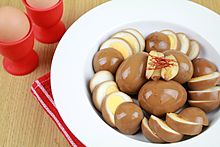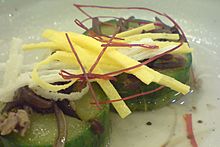Chili thread facts for kids
 |
|
| Alternative names | Chilli threads, chili pepper threads, sil-gochu |
|---|---|
| Type | Garnish |
| Place of origin | Korea |
| Associated national cuisine | Korean cuisine |
| Main ingredients | Chili peppers |
| Korean name | |
| Hangul |
실고추
|
|---|---|
| Hanja |
실苦椒
|
| Revised Romanization | sil-gochu |
| McCune–Reischauer | sil-koch'u |
| IPA | [ɕil.ɡo.tɕʰu] |
Sil-gochu (실고추), often called chili threads or chili pepper threads, are a unique and traditional food decoration from Korea. These thin, colorful strands are made from dried chili peppers. They add a beautiful touch and a mild, spicy flavor to many Korean dishes.
Contents
What are Chili Threads?
Chili threads are long, thin strands of dried chili pepper. They look a bit like red string or fine noodles. In Korea, they are known as sil-gochu. The word sil means "thread" and gochu means "chili pepper".
How are Chili Threads Made?
Making chili threads is a careful process. First, ripe chili peppers are picked. Then, they are dried, often in the sun. Once dry, the peppers are split open. The seeds and inner membranes are removed. This step is important because it makes the threads less spicy. Finally, the dried pepper skin is cut into very thin strips. These strips become the beautiful sil-gochu.
Why Use Chili Threads?
Chili threads are used for a few reasons:
- Decoration: They add a bright red color to dishes. This makes the food look more appealing.
- Flavor: They give a very mild, smoky chili flavor. It's not usually super spicy.
- Texture: They add a slight chewiness to the dish.
You'll often see them sprinkled on top of a finished meal. They are like edible confetti for your food!
Where are Chili Threads Used?
Chili threads are a common sight in Korean cuisine. They are used in many different types of dishes.
Popular Korean Dishes
You might find sil-gochu on:
- Soups and stews: They float on top, adding color.
- Stir-fries: They mix in with vegetables and meat.
- Salads: They provide a pop of color and mild spice.
- Garnishes: They are often placed on top of bibimbap or other rice dishes.
- Side dishes: Many traditional Korean side dishes, called banchan, use them.
They are especially popular for special occasions or when presenting food beautifully.
Gallery



